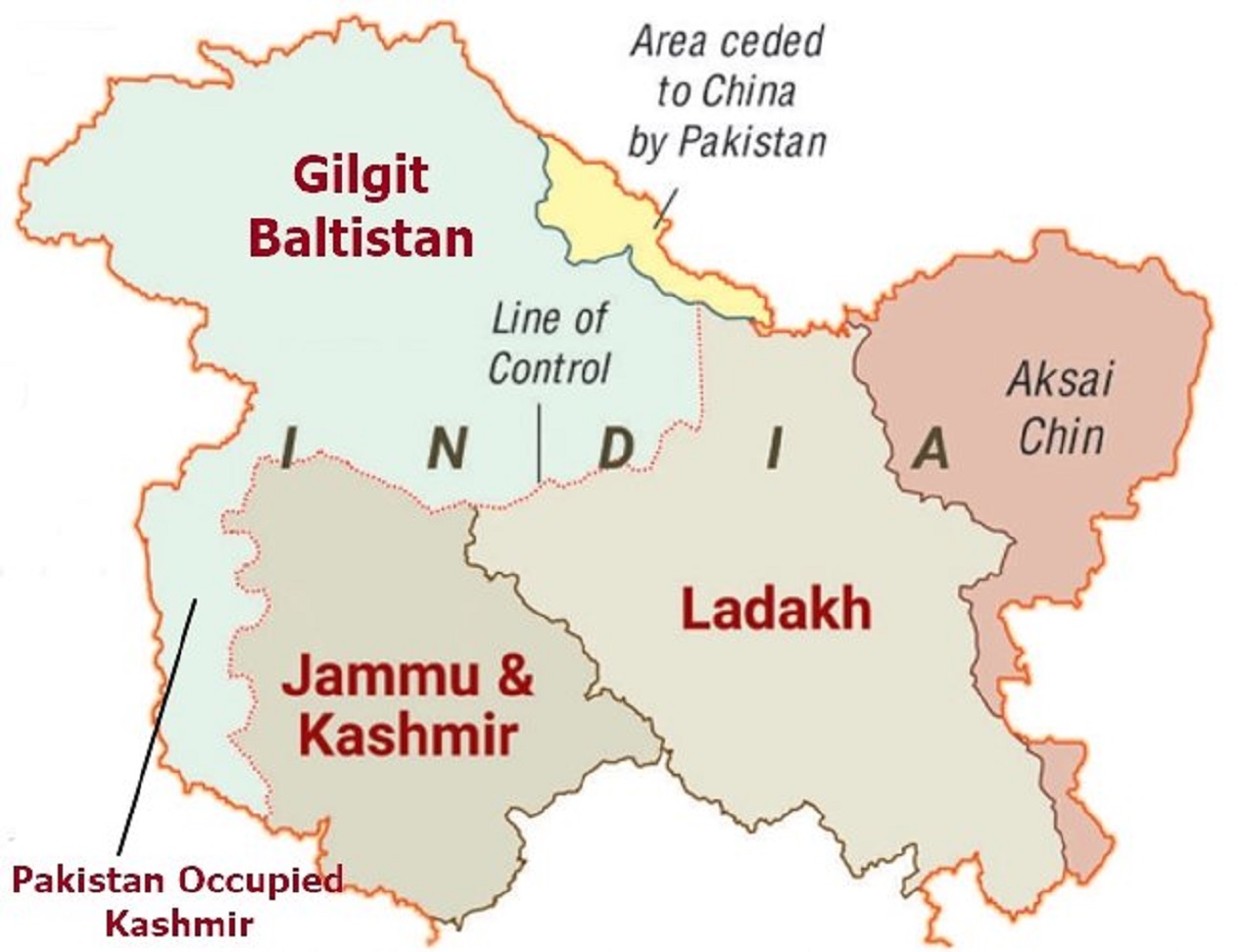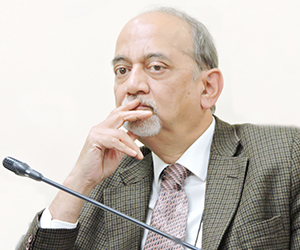Pakistan Occupied Kashmir (POK) elected a new so called ‘Prime Minister’ on April 18th barely a week after Imran Khan Niazi’s ouster in Islamabad. PTI government headed by the outgoing ‘Prime Minister’ Abdul Qayyum Khan Niazi had completed just 9 months in office. The POK assembly was elected only in July 2021. The ‘Prime Minister’ enjoyed a comfortable majority in the assembly. PTI had won 25 seats in the last elections; Niazi was elected the 13th ‘Prime Minister’ with a vote of 33 members. What then triggered the change? Why did Niazi have to follow the exit of his namesake in Islamabad? A common surname between the two was only a coincidence. But the change in Muzaffarabad soon after the change in Islamabad follows an established pattern. POK is ‘Azad’ only in name despite the high titles accorded to its functionaries.
The ‘Prime Minister’ was changed through a vote on the floor of the House. This may appear a normal position in a democracy. However, in this case, the No-Confidence motion was sponsored by the Prime Minister’s party only. It was carried out by a vote of 33 members with 19 opposition members belonging to the PML-N and PPP boycotting the proceedings.[1]The incumbent Sardar Tanveer Ilyas also belongs to PTI. If it was an intra-party change, the procedure to bring it about is curious. A vote in the Assembly is not the usual route to settle differences within the party. Some PTI members claim that the change had Imran Khan’s blessings. Why would Imran Khan attempt such a change after losing power at the Federal level? He had selected Niazi as ‘Prime Minister’ of the territory; he could have dismissed him earlier while he was Pakistan’s Prime Minister. To make the change after his ouster at the Federal level risked losing power in POK as well.
The ultimate arbiter of the dispensation in the POK is Pakistan Army. The new so called ‘Prime Minister’ soon after getting elected made sharp comments on the situation on the Indian side of the LOC. He criticized the arrest of JKLF leader Yasin Malik.[2] He alleged that India has issued 4.2 million domicile certificates to non-Kashmiris with a view to changing the demographic composition of the region.[3] Whether this was on a cue from the Army or the new civilian leadership in Islamabad is difficult to say. Sardar Tanveer Ilyas has his domestic political compulsions. He admitted that the biggest problem facing the youth was unemployment. Making wild allegations against India helps divert attention. Whatever be the motivation, rhetoric has gone up sharply.
While Pakistan and the POK regime have chosen to rake up the JKLF leader’s case, no pro-independence party is allowed to participate in elections in POK. This ban has been built into POK’s constitution. Under Article 4.7(3) of POK’s ‘Interim Constitution’, ‘No person or political party in Azad Jammu and Kashmir shall be permitted to propagate against, or take part in activities prejudicial or detrimental to, the ideology of the State’s accession to Pakistan.’ [4]This is further reinforced by wordings of the oath the elected members and government functionaries have to take up. No pro-independence candidate has been ever allowed to take part in elections in POK. This included Amanullah Khan, one of the most prominent leaders of JKLF. He has given an account of the ban in his interview with the Human Rights Watch.[5]
Change in the Demographic Composition
Under POK’s ‘Interim Constitution’, migration from and into POK was included in the legislative competence of the Council headed by Pakistan’s Prime Minister rather than under the jurisdiction of the POK Assembly. [6] This stratagem at one stroke removed control over the demographic composition of the territory from the jurisdiction of the POK government. Though the POK ‘Interim Constitution’ includes a definition of the State subject based on Maharaja’s notification of 1927, this has been diluted by defining ‘State Subject as a person for the time being residing in Azad Jammu and Kashmir or Pakistan who is a State Subject, as defined in the late Government of the State of Jammu and Kashmir……..’[7] This makes the definition more ambiguous and liable to misuse. The problem is immensely complicated by the fact that as many as 12 ‘refugee seats’ lie outside POK. In the absence of any clear demarcation or safeguard, Pakistan has changed the demographic composition of the POK. Even the loose definition of State Subject in the ‘Interim Constitution Act of 1974’ came more than a quarter-century after Pakistan had illegally occupied the territory.
Sardar Tanveer Ilyas’s ‘election’ as Pakistan’s prime minister ostensibly inaugurates a new government. Such changes have little meaning since neither the elected assembly nor the government enjoys any power. The ‘Interim Constitution’ of 1974 vested these powers in the Council headed by Pakistan’s Prime Minister. The 13th amendment of the POK constitution has relegated the Council to an advisory role. But instead of transferring its powers to the elected assembly, these have been assumed directly by Islamabad. Pakistan now enjoys direct legislative powers inside POK over 32 subjects. Even on the remaining 22 subjects, the elected assembly can legislate only with Pakistan’s approval. This is more intrusive than the Federal government’s control over Pakistan’s provinces. In their case, the Federal government cannot legislate on state subjects. On the other hand, provinces do not need the Federal government’s approval to legislate on subjects within their jurisdiction. The so-called ‘Azad’ Kashmir is more tightly controlled than Pakistan’s provinces.
Islamabad controls all the key economic levers in POK. This includes taxation, water, and strategic highways. Not only POK does not control demographic composition, but it also has no control over its territory. 85% of the territory of the state of J&K illegally occupied by Pakistan consists of the Northern Areas. This has been separated from POK and brought under Pakistan’s direct control since its inception. Pakistan has now changed its name to Gilgit-Baltistan. This seemingly innocuous change essentially obscures the historical origin of the territory. More importantly, it disguises Pakistan’s action in changing the territorial status quo without a plebiscite. POK High Court in its verdict of 1993 had described this as a violation of the UN Security Council resolutions, which Pakistan claims to uphold as sacrosanct.
Incidentally, Abdul Qayyum Khan had assumed the surname Niazi to avoid being mistaken for one of his illustrious predecessors who bore the same name.[8] For Imran Khan, ‘Niazi’ is indeed his family name, but he does not like to acknowledge it as the name evokes memories of the Pakistan army’s surrender at Dhaka in 1971. The surrender document was signed by another Niazi – General Niazi.
The change in POK may not be the end of the story. A similar change may be in offing in Gilgit-Baltistan (G-B). The rumblings began immediately after Imran Khan’s ouster. GB has a PTI government. A joint declaration by the opposition parties in G-B called for the ouster of the G-B Chief Minister.[9] This was followed by a statement by the Advisor to the PM for Gilgit-Baltistan Kamar Zaman Kaira that the PTI government in G-B will be ousted just as the rule of the former Prime Minister came to an end lately.[10] The situation has escalated since. The CM Khalid Khorshid claimed that while he was on his way to join a rally called by Imran Khan, Punjab Police opened up shelling on his car.[11] G-B is more important to Pakistan’s military than POK. China Pakistan Economic Corridor (CPEC) enters Pakistan through G-B. The region has more water and hydro-power resources than POK and has a growing Chinese presence.
Endnotes :
[1]Dawn, TanveerIlyas sworn in as AJK Premier, April 19, 2033
[2]YouTube, PM Azad Kashmir, SardarTanveerIlyas, Sensational Speech, April 24, 2022, www.CharsaddaJournalist.com
[3]YouTube, Big Developments on J&K issue, AJK prime minister SardarTanveerIlyas Talk, Wahjoc, Kashmir, June 4, 2022
[4]Forgotten Kashmir: The Other Side of the Line of Control, Page 325
[5]Forgotten Kashmir: The Other Side of the Line of Control, Page 329
[6]Forgotten Kashmir: The Other Side of the Line of Control, Page 147
[7]Forgotten Kashmir: The Other Side of the Line of Control’, Page 147
[8]Profile, How new AJK prime minister became a Nihazi, August 5, 2021
[9]Dawn, Opposition in GB decides to oust CM Khan, May 11, 2022
[10]Dawn: Kaira promises ouster of Gilgit-Baltistan, May 14, 2022
[11]Express Tribune, Gilgit Baltistan CM Claims Police Unleashed Shelling on his Car, May 29, 2022
(The paper is the author’s individual scholastic articulation. The author certifies that the article/paper is original in content, unpublished and it has not been submitted for publication/web upload elsewhere, and that the facts and figures quoted are duly referenced, as needed, and are believed to be correct). (The paper does not necessarily represent the organisational stance... More >>
Image Source: https://www.drishtiias.com/images/uploads/1600420482_image2.jpg











Post new comment